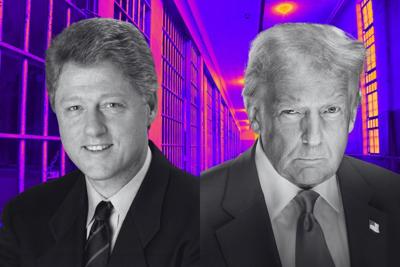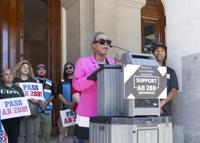
(Canva; Bob McNeely/The White House; Daniel Torok/United States Library of Congress / Wikimedia Commons)
This is the story of my personal and academic journey into the prison industrial complex, a system that has evolved from the policies of Bill Clinton to those of Donald Trump.
I grew up in poor and working-class communities across the northeast San Fernando Valley, a former suburb of Los Angeles. I graduated from Langdon Ave. Elementary School, a few years before many of the boys were named in the gang injunction. But long before the injunction, I watched some of the “bad kids” begin to disappear – first into juvenile hall, then county jail, before maxing out with the California Department of Corrections and rehabilitation (CDCr); lower case “r” is not a typo, but an acknowledgement that rehabilitation happens on a very small scale. It has been 34 years since I graduated high school, and some of the guys are still with the CDCr.
Initially, as a teenager with a limited understanding of the world, I rationalized their incarceration. After all, they did “steal a car” or “were caught selling drugs.” But when I enrolled at Los Angeles Valley College (LAVC), sociology professor Pat Allen introduced me to the system’s inconvenient truth. Though I knew my friends weren't entirely innocent, Professor Allen revealed how the prison system itself was guilty of wrongdoing. I was 17 that first semester, reading at a fifth-grade level, and attending college was an act of rebellion against my father and my high school’s college advisor, who suggested I learn to paint cars at an occupational center.
Before arriving at LAVC, I never considered that U.S. history extended beyond the dead presidents showcased in high school textbooks. But lo and behold, I discovered that the “history of prisons” was a legitimate field of study. I was immediately intrigued by the topic, given that I knew more incarcerated people than those who drove with me to college. In the late 80s and early 90s, gatekeepers like my high school advisor were still a dime a dozen, making it extremely challenging for certain students to even know that community college was an option.
During my first year at LAVC, I volunteered for Friends Outside, a Pasadena nonprofit that helped incarcerated people reconnect with their loved ones. Long before the World Wide Web, my assignment was to open letters from the incarcerated, become a sleuth and reconnect them with family using the white pages or any other provided clue. That brief experience was a masterclass in heartbreak, revealing countless stories of people literally lost in the system. Tracking down family members across the nation gave depth to my understanding and intensified my curiosity about prisons.
By September of 1999, I enrolled in the Master of Arts in Urban Planning at UCLA. It was then and there, through a classmate, that I was formally introduced to the Prison Industrial Complex (PIC). The literature I reviewed was profoundly disturbing, and the following were my biggest takeaways.
· Between 1970 and 2000, California built more prisons than universities.
· Private prison stocks were traded on Wall Street.
· The Clinton administration used prisons to revitalize rural and nonmetropolitan economies on the basis that prisons were pollution-free and recession-proof.
· Laws at all levels of government were racialized for the purpose of incarcerating Black and Brown people; for example, gang injunctions were never applied to white communities.
In 2010, while working on a Ph.D. at UCLA, I read Michelle Alexander’s book, “The New Jim Crow: Mass Incarceration In the Age of Colorblindness.” Alexander’s book inspired my first published article, “Arizona: From Jim Crow to Juan Cuervo.” The political landscape had shifted from a decade earlier, and in that first publication, I argued:
?Coincidentally, several factors have led to an anti‐immigrant hysteria at a time when the nation reaches a point of maximizing the number of Black male inmates. This intersection of a maximized Black male inmate population and the need to expand the Prison Industrial Complex creates a circumstance for immigrants to be the new placeholders; needed for the incarceration industry to continue thriving.”
In 2015, shortly after completing a Ph.D. I accepted a position with CDCr, teaching Social Studies at a N.A. Chaderjian, a state youth prison in Stockton, California. Spending eight hours a day inside a state prison for four years profoundly deepened my understanding of its impact on everyone involved.
In 2017, while teaching inside Stockton’s HealthCare Facility Prison, I regularly saw a person who resembled Danny Rodriguez (#LA8822), the first “bad kid” who disappeared into the county juvenile hall and eventually CDCr; he was part of the maintenance crew in the school yard. While I was not certain that it was Danny, and I was under the impression that he had been killed inside prison, his signature smile occupied my thoughts. I was eventually transferred to another prison, and did not confirm if it was Danny.
In 2020, soon after Danny was released, we reconnected, and I was able to confirm my observation. Danny was sentenced to 35-to-life on a three-strikes conviction but was eventually released after 25 years. Taxpayers paid approximately $3,800,000.00 for Danny’s 25-year incarceration, for allegedly stealing a purse, a non-violent offense which he maintains to be innocent.
Today, as the Trump administration ramps up its deportation campaign while simultaneously building private facilities to incarcerate immigrants, the math is not mathing. Deportation and detention require two distinct budgets. Deportation is a one-way ticket to the motherland; detention is a recurring expense, with costs for guards, utilities, food and medical care—a budget comparable to a regular prison.
When Arnold Schwarzenegger campaigned for California governor, he proposed, as a budget solution, paying Mexico to incarcerate California inmates at a lower cost. Many laughed, citing the U.S. Constitution. Yet here we are, paying El Salvador and other nations to incarcerate immigrants who should have been returned to their home countries, instead of being imprisoned without due process.
Shortly after Kamala Harris conceded the presidential race, several stock market analysts provided a short list of industries to invest in for a second Trump term. Overwhelmingly, private prison corporations made the short list.
Today, I am regularly reminded of my first publication, where I forecasted that immigrants would become the primary target to maintain and expand the Prison Industrial Complex. What most MAGA followers have yet to grasp is that Trump’s idea of “deporting immigrants” is the opposite of theirs. Trump is using immigrants to grow the private prison industry, funneling tax dollars into warehousing human beings for the sake of Wall Street profits.
For math to truly math, one must consider that in 2023, undocumented immigrants contributed approximately $90 billion in local, state and federal taxes that they would never claim. Over the years, this has been a major contribution to the Social Security budget that will now diminish faster.
In addition to immigrants being removed from the labor market and their tax contributions, it will cost U.S. taxpayers approximately $125,000.00 per person, per year, to warehouse them. Inside prison, most will not work – the percentage of people who toil for pennies on the hour is the minority.
Essentially, we have reached a new level of capitalism: unlike the image of backbreaking slave labor and sweatshops, corporations now generate profit by having people sit idle in a cell.










(0) comments
Welcome to the discussion.
Log In
Keep it Clean. Please avoid obscene, vulgar, lewd, racist or sexually-oriented language.
PLEASE TURN OFF YOUR CAPS LOCK.
Don't Threaten. Threats of harming another person will not be tolerated.
Be Truthful. Don't knowingly lie about anyone or anything.
Be Nice. No racism, sexism or any sort of -ism that is degrading to another person.
Be Proactive. Use the 'Report' link on each comment to let us know of abusive posts.
Share with Us. We'd love to hear eyewitness accounts, the history behind an article.